User:Kirschtaria/sandbox/아바스 칼리파국 번역용
History
The Abbasid caliphs were Arabs descended from Abbas ibn Abd al-Muttalib, one of the youngest uncles of Muhammad and of the same Banu Hashim clan. The Abbasids claimed to be the true successors of Muhammad in replacing the Umayyad descendants of Banu Umayya by virtue of their closer bloodline to Muhammad.
Abbasid Revolution (750–751)
The Abbasids also distinguished themselves from the Umayyads by attacking their moral character and administration in general. According to Ira Lapidus, "The Abbasid revolt was supported largely by Arabs, mainly the aggrieved settlers of Merv with the addition of the Yemeni faction and their Mawali".[1] The Abbasids also appealed to non-Arab Muslims, known as mawali, who remained outside the kinship-based society of the Arabs and were perceived as a lower class within the Umayyad empire. Muhammad ibn 'Ali, a great-grandson of Abbas, began to campaign in Persia for the return of power to the family of Muhammad, the Hashemites, during the reign of Umar II.
During the reign of Marwan II, this opposition culminated in the rebellion of Ibrahim al-Imam, the fourth in descent from Abbas. Supported by the province of Khorasan (Eastern Persia), even though the governor opposed them, and the Shia Arabs,[2][3] he achieved considerable success, but was captured in the year 747 and died, possibly assassinated, in prison.
On 9 June 747 (15 Ramadan AH 129), Abu Muslim, rising from Khorasan, successfully initiated an open revolt against Umayyad rule, which was carried out under the sign of the Black Standard. Close to 10,000 soldiers were under Abu Muslim's command when the hostilities officially began in Merv.[4] General Qahtaba followed the fleeing governor Nasr ibn Sayyar west defeating the Umayyads at the Battle of Gorgan, the Battle of Nahavand and finally in the Battle of Karbala, all in the year 748.[3]
Ibrahim was captured by Marwan and was killed. The quarrel was taken up by Ibrahim's brother Abdallah, known by the name of Abu al-'Abbas as-Saffah, who defeated the Umayyads in 750 in the battle near the Great Zab and was subsequently proclaimed caliph.[5] After this loss, Marwan fled to Egypt, where he was subsequently killed. The remainder of his family, barring one male, were also eliminated.[3]
Rise to power (752–775)

Immediately after their victory, al-Saffah sent his forces to Central Asia, where his forces fought against Tang expansion during the Battle of Talas. Al-Saffah focused on putting down numerous rebellions in Syria and Mesopotamia. The Byzantines conducted raids during these early distractions.[3]
One of the first major changes effected by Abbasid rule was the move of the caliphate's center of power from Syria to Mesopotamia (present-day Iraq). This was closer to the Persian mawali support base of the Abbasids and the move addressed their demand for reduced Arab dominance in the empire.[6] However, no definitive capital was yet selected. In these early Abbasid years, Kufa generally served as the administrative capital, but the caliphs were wary of the Alid sympathies in the city and did not always reside here.[7] In 752, al-Saffah built a new city called al-Hashimiyya, at an uncertain location, most likely near Kufa.[8] Later that same year, he moved to Anbar, where he built a new settlement for his Khurasani soldiers and a palace for himself.[9]
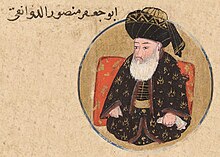
It was al-Saffah's successor, Abu Ja'far al-Mansur (r. 754–775) who firmly consolidated Abbasid rule and faced down internal challenges.[10] His uncle, Abdallah ibn Ali, the victor over the Umayyads at the Battle of the Zab, was the most serious potential rival for leadership and al-Mansur sent Abu Muslim, the Khurasani revolutionary commander, against him in 754. After Abu Muslim successfully defeated him, al-Mansur then turned to eliminate Abu Muslim himself. He arranged to have him arrested and executed in 755.[11]
On the western frontier, the Abbasids were unable to re-assert caliphal control over the western and central Maghreb, which the Umayyads had lost in the 740s.[12] One member of the Umayyad dynasty, Abd ar-Rahman, also managed to escape the purge of his family and managed to establish independent in rule in al-Andalus (present-day Spain and Portugal) in 756, founding the Umayyad Emirate of Córdoba.[13]
In 756, al-Mansur had also sent over 4,000 Arab mercenaries to assist the Chinese Tang dynasty in the An Lushan Rebellion against An Lushan. The Abbasids, or "Black Flags" as they were commonly called, were known in Tang dynasty chronicles as the hēiyī Dàshí, "The Black-robed Tazi" (黑衣大食) ("Tazi" being a borrowing from Persian Tāzī, the word for "Arab").[nb 1][nb 2][nb 3][nb 4][nb 5] Al-Rashid sent embassies to the Chinese Tang dynasty and established good relations with them.[19][nb 6][nb 7][22][23][24][25][26] After the war, these embassies remained in China[27][28][29][30][31] with Caliph Harun al-Rashid establishing an alliance with China.[19] Several embassies from the Abbasid Caliphs to the Chinese court have been recorded in the Old Book of Tang, the most important being those of al-Saffah, al-Mansur, and Harun al-Rashid.
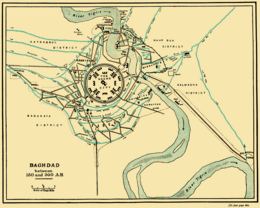
In 762, al-Mansur suppressed a rebellion in the Hijaz led by al-Nafs al-Zakiyya, a descendant from Ali ibn Abi Talib, whose challenge to the Abbasid claim to leadership was based on his Alid lineage and thus presented a serious political threat. He was defeated by an Abbasid army led by Isa ibn Musa.[32] It was after this victory, in 762, that al-Mansur finally established a proper Abbasid capital, Baghdad – officially called Madinat al-Salam ('City of Peace') – located on the Tigris River.[33] Prior to this, he had continued to consider multiple sites for a capital, including al-Hashimiyya, which he used as a capital for a while.[34] Various other sites in the region also appear to have served as "capitals" under either al-Saffah or al-Mansur prior to the founding of Baghdad.[8]
Al-Mansur centralised the judicial administration, and later, Harun al-Rashid established the institution of Chief Qadi to oversee it.[35] The Umayyad empire was mostly Arab; however, the Abbasids progressively became made up of more and more converted Muslims in which the Arabs were only one of many ethnicities.[36] The Abbasids had depended heavily on the support of Persians[2] in their overthrow of the Umayyads. Al-Mansur welcomed non-Arab Muslims to his court. While this helped integrate Arab and Persian cultures, it alienated many of their Arab supporters, particularly the Khorasanian Arabs who had supported them in their battles against the Umayyads.[citation needed]
Abbasid Golden Age (775–861)
The Abbasid leadership had to work hard in the last half of the 8th century (750–800) under several competent caliphs and their viziers to usher in the administrative changes needed to keep order of the political challenges created by the far-flung nature of the empire, and the limited communication across it.[37] It was also during this early period of the dynasty, in particular during the governance of Al-Mansur, Harun al-Rashid, and al-Ma'mun, that its reputation and power were created.[2]
The position of wazir (vizier) developed in this period. It was initially akin to a secretary, but under the tenure of the Barmakids, an Iranian family close to the Abbasids, the position became powerful and Harun al-Rashid delegated state affairs to them for many years.[38] This resulted in a more ceremonial role for many Abbasid caliphs relative to their time under the Umayyads; the viziers began to exert greater influence, and the role of the old Arab aristocracy was slowly replaced by a Persian bureaucracy.[6] To the west, Harun al-Rashid agreed to grant the province of Ifriqiya (centered in present-day Tunisia) as a hereditary emirate to Ibrahim ibn al-Aghlab, who founded the Aghlabid dynasty there.[39]
Al-Mahdi restarted the fighting with the Byzantines, and his sons continued the conflict until Empress Irene pushed for peace.[3] After several years of peace, Nikephoros I broke the treaty, then fended off multiple incursions during the first decade of the 9th century. These attacks pushed into the Taurus Mountains, culminating with a victory at the Battle of Krasos and the massive invasion of 806, led by Rashid himself.[40]

Rashid's navy also proved successful, taking Cyprus. Rashid decided to focus on the rebellion of Rafi ibn al-Layth in Khorasan and died while there.[40] Military operations by the caliphate were minimal while the Byzantine Empire was fighting Abbasid rule in Syria and Anatolia, with focus shifting primarily to internal matters; Abbasid governors exerted greater autonomy and, using this increasing power, began to make their positions hereditary.[6]
While Baghdad remained the official capital, Harun al-Rashid chose to reside in Raqqa from 796 until the end of his reign.[39][nb 8] In 803, for reasons that remain unclear,[43] Harun al-Rashid turned on and imprisoned or killed most of the Barmakids, who had wielded administrative power on his behalf.[44][43] During the same period, several factions began either to leave the empire for other lands or to take control of distant parts of the empire. Still, the reigns of al-Rashid and his sons were considered to be the apex of the Abbasids.[45]
Domestically, Harun pursued policies similar to those of his father Al-Mahdi. He released many of the Umayyads and 'Alids his brother Al-Hadi had imprisoned and declared amnesty for all political groups of the Quraysh.[46] Large scale hostilities broke out with Byzantium, and under his rule, the Abbasid Empire reached its peak.[47] However, Harun's decision to split the succession proved to be damaging to the longevity of the empire.[48]
After Rashid's death, the empire was split by a civil war between the caliph al-Amin and his brother al-Ma'mun, who had the support of Khorasan. This war ended with a two-year siege of Baghdad and the eventual death of Al-Amin in 813.[40] Al-Ma'mun ruled for 20 years of relative calm interspersed with a rebellion in Azerbaijan by the Khurramites, which was supported by the Byzantines. Al-Ma'mun was also responsible for the creation of an autonomous Khorasan, and the continued repulsing of Byzantine forays.[40]
In the 9th century, the Abbasids created an army loyal only to their caliphate, composed of non-Arab origin people, known as Mamluks.[49][50][51][52][53] This force, created by al-Ma'mun and his brother and successor al-Mu'tasim (833–842), prevented the further disintegration of the empire. The Mamluk army, though often viewed negatively, both helped and hurt the caliphate. Early on, it provided the government with a stable force to address domestic and foreign problems. However, creation of this foreign army and al-Mu'tasim's transfer of the capital from Baghdad to Samarra created a division between the caliphate and the peoples they claimed to rule.[5]
Al-Mu'tasim's reign marked the end of the strong caliphs. He strengthened his personal army with the Mamluks and promptly restarted the war with the Byzantines. Though his attempt to seize Constantinople failed when his fleet was destroyed by a storm,[54] his military excursions were generally successful, culminating with a resounding victory in the Sack of Amorium. The Byzantines responded by sacking Damietta in Egypt, and Al-Mutawakkil responded by sending his troops into Anatolia again, sacking and marauding until they were eventually annihilated in 863.[55]
Fracture to autonomous dynasties (861–945)
Even by 820, the Samanids had begun the process of exercising independent authority in Transoxiana and Greater Khorasan, and the succeeding Saffarid dynasty of Iran. The Saffarids, from Khorasan, nearly seized Baghdad in 876, and the Tulunids took control of most of Syria. The trend of weakening of the central power and strengthening of the minor caliphates on the periphery continued.[45]
An exception was the 10-year period of Al-Mu'tadid's rule (r. 892–902). He brought parts of Egypt, Syria, and Khorasan back into Abbasid control. Especially after the "Anarchy at Samarra" (861–870), the Abbasid central government was weakened and centrifugal tendencies became more prominent in the caliphate's provinces. By the early 10th century, the Abbasids almost lost control of Iraq to various amirs, and the caliph al-Radi (934–941) was forced to acknowledge their power by creating the position of "Prince of Princes" (amir al-umara).[45] In addition, the power of the Mamluks steadily grew, reaching a climax when al-Radi was constrained to hand over most of the royal functions to the non-Arab Muhammad ibn Ra'iq.[5]
Al-Mustakfi had a short reign from 944 to 946, and it was during this period that the Persian faction known as the Buyids from Daylam swept into power and assumed control over the bureaucracy in Baghdad. According to the history of Miskawayh, they began distributing iqtas (fiefs in the form of tax farms) to their supporters. This period of localized secular control was to last nearly 100 years.[2] The loss of Abbasid power to the Buyids would shift as the Seljuks would take over from the Persians.[45]
At the end of the eighth century, the Abbasids found they could no longer keep together a polity from Baghdad, which had grown larger than that of Rome. In 793 the Zaydi-Shia dynasty of Idrisids set up a state from Fez in Morocco, while a family of governors under the Abbasids became increasingly independent until they founded the Aghlabid Emirate from the 830s. Al-Mu'tasim started the downward slide by using non-Muslim mercenaries in his personal army. Also during this period, officers started assassinating superiors with whom they disagreed, in particular the caliphs.[2]

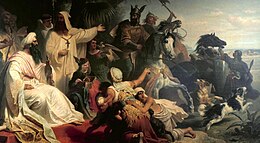
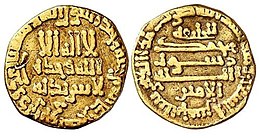

By the 870s, Egypt became autonomous under Ahmad ibn Tulun. In the East, governors decreased their ties to the center as well. The Saffarids of Herat and the Samanids of Bukhara began breaking away around this time, cultivating a much more Persianate culture and statecraft. Only the central lands of Mesopotamia were under direct Abbasid control, with Palestine and the Hijaz often managed by the Tulunids. Byzantium, for its part, had begun to push Arab Muslims farther east in Anatolia.
By the 920s, North Africa was lost to the Fatimid dynasty, a Shia sect tracing its roots to Muhammad's daughter Fatimah. The Fatimid dynasty took control of Idrisid and Aghlabid domains,[45] advanced to Egypt in 969, and established their capital near Fustat in Cairo, which they built as a bastion of Shia learning and politics. By 1000 they had become the chief political and ideological challenge to Sunni Islam and the Abbasids, who by this time had fragmented into several governorships that, while recognizing caliphal authority from Baghdad, remained mostly autonomous. The caliph himself was under 'protection' of the Buyid Emirs who possessed all of Iraq and Western Iran, and were quietly Shia in their sympathies.

Outside Iraq, all the autonomous provinces slowly took on the characteristic of de facto states with hereditary rulers, armies, and revenues and operated under only nominal caliph suzerainty, which may not necessarily be reflected by any contribution to the treasury, such as the Soomro Emirs that had gained control of Sindh and ruled the entire province from their capital of Mansura.[37] Mahmud of Ghazni took the title of sultan, as opposed to the "amir" that had been in more common usage, signifying the Ghaznavid Empire's independence from caliphal authority, despite Mahmud's ostentatious displays of Sunni orthodoxy and ritual submission to the caliph. In the 11th century, the loss of respect for the caliphs continued, as some Islamic rulers no longer mentioned the caliph's name in the Friday khutba, or struck it off their coinage.[37]
The Isma'ili Fatimid dynasty of Cairo contested the Abbasids for the titular authority of the Islamic ummah. They commanded some support in the Shia sections of Baghdad (such as Karkh), although Baghdad was the city most closely connected to the caliphate, even in the Buyid and Seljuq eras. The challenge of the Fatimids only ended with their downfall in the 12th century.
Buyid and Seljuq control (945–1118)

Despite the power of the Buyid amirs, the Abbasids retained a highly ritualized court in Baghdad, as described by the Buyid bureaucrat Hilal al-Sabi', and they retained a certain influence over Baghdad as well as religious life. As Buyid power waned with the rule of Baha' al-Daula, the caliphate was able to regain some measure of strength. The caliph al-Qadir, for example, led the ideological struggle against the Shia with writings such as the Baghdad Manifesto. The caliphs kept order in Baghdad itself, attempting to prevent the outbreak of fitnas in the capital, often contending with the ayyarun.
With the Buyid dynasty on the wane, a vacuum was created that was eventually filled by the dynasty of Oghuz Turks known as the Seljuqs. By 1055, the Seljuqs had wrested control from the Buyids and Abbasids, and took temporal power.[2] When the amir and former slave Basasiri took up the Shia Fatimid banner in Baghdad in 1056–57, the caliph al-Qa'im was unable to defeat him without outside help. Toghril Beg, the Seljuq sultan, restored Baghdad to Sunni rule and took Iraq for his dynasty.
Once again, the Abbasids were forced to deal with a military power that they could not match, though the Abbasid caliph remained the titular head of the Islamic community. The succeeding sultans Alp Arslan and Malikshah, as well as their vizier Nizam al-Mulk, took up residence in Persia, but held power over the Abbasids in Baghdad. When the dynasty began to weaken in the 12th century, the Abbasids gained greater independence once again.
Revival of military strength (1118–1258)
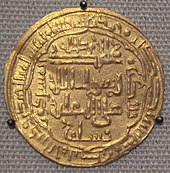
While the caliph al-Mustarshid was the first caliph to build an army capable of meeting a Seljuk army in battle, he was nonetheless defeated and assassinated in 1135. The caliph al-Muqtafi was the first Abbasid Caliph to regain the full military independence of the caliphate, with the help of his vizier Ibn Hubayra. After nearly 250 years of subjection to foreign dynasties, he successfully defended Baghdad against the Seljuqs in the siege of Baghdad (1157), thus securing Iraq for the Abbasids. The reign of al-Nasir (d. 1225) brought the caliphate back into power throughout Iraq, based in large part on the Sufi futuwwa organizations that the caliph headed.[45] Al-Mustansir built the Mustansiriya School, in an attempt to eclipse the Seljuq-era Nizamiyya built by Nizam al Mulk.
Mongol invasion and end
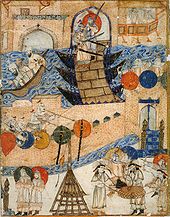
In 1206, Genghis Khan established a powerful dynasty among the Mongols of central Asia. During the 13th century, this Mongol Empire conquered most of the Eurasian land mass, including both China in the east and much of the old Islamic caliphate (as well as Kievan Rus') in the west. Hulagu Khan's destruction of Baghdad in 1258 is traditionally seen as the approximate end of the Golden Age.[56]
Contemporary accounts state Mongol soldiers looted and then destroyed mosques, palaces, libraries, and hospitals. Priceless books from Baghdad's thirty-six public libraries were torn apart, the looters using their leather covers as sandals.[57] Grand buildings that had been the work of generations were burned to the ground. The House of Wisdom (the Grand Library of Baghdad), containing countless precious historical documents and books on subjects ranging from medicine to astronomy, was destroyed. Claims have been made that the Tigris ran red from the blood of the scientists and philosophers killed.[58][59] Citizens attempted to flee, but were intercepted by Mongol soldiers who killed in abundance, sparing no one, not even children.
The caliph Al-Musta'sim was captured and forced to watch as his citizens were murdered and his treasury plundered. Ironically, Mongols feared that a supernatural disaster would strike if the blood of Al-Musta'sim, a direct descendant of Muhammad's uncle Abbas ibn Abd al-Muttalib,[60] and the last reigning Abbasid caliph in Baghdad, was spilled. The Shia of Persia stated that no such calamity had happened after the death of Husayn ibn Ali in the Battle of Karbala; nevertheless, as a precaution and in accordance with a Mongol taboo which forbade spilling royal blood, Hulagu had Al-Musta'sim wrapped in a carpet and trampled to death by horses on 20 February 1258. The caliph's immediate family was also executed, with the lone exceptions of his youngest son who was sent to Mongolia, and a daughter who became a slave in the harem of Hulagu.[61]
Abbasid Caliphate of Cairo (1261–1517)
Similarly to how a Mamluk Army was created by the Abbasids, a Mamluk Army was created by the Egypt-based Ayyubid dynasty. These Mamluks decided to directly overthrow their masters and came to power in 1250 in what is known as the Mamluk Sultanate. In 1261, following the devastation of Baghdad by the Mongols, the Mamluk rulers of Egypt re-established the Abbasid caliphate in Cairo. The first Abbasid caliph of Cairo was Al-Mustansir. The Abbasid caliphs in Egypt continued to maintain the presence of authority, but it was confined to religious matters.[citation needed] The Abbasid caliphate of Cairo lasted until the time of Al-Mutawakkil III, who was taken away as a prisoner by Selim I to Constantinople where he had a ceremonial role. He died in 1543, following his return to Cairo.[citation needed]
- ^ Lapidus 2002, p. 54.
- ^ a b c d e f Hoiberg 2010, p. 10.
- ^ a b c d e Dupuy & Dupuy 1986, p. 233.
- ^ Lewis 1995, p. 102.
- ^ a b c Chisholm, Hugh, ed. (1911). . Encyclopædia Britannica. Vol. 1 (11th ed.). Cambridge University Press. p. 10.
- ^ a b c University of Calgary 1998
- ^ Djaït, Hichem (1986). "al-Kūfa". In Bosworth, C. E.; van Donzel, E.; Lewis, B. & Pellat, Ch. (eds.). The Encyclopaedia of Islam, Second Edition. Volume V: Khe–Mahi. Leiden: E. J. Brill. p. 347. ISBN 978-90-04-07819-2.
- ^ a b Lassner, J. (1971). "al-Hās̲h̲imiyya". In Lewis, B.; Ménage, V. L.; Pellat, Ch. & Schacht, J. (eds.). The Encyclopaedia of Islam, Second Edition. Volume III: H–Iram. Leiden: E. J. Brill. pp. 265–266. OCLC 495469525.
- ^ Streck, M. & Duri, A.A. (1960). "al-Anbār". In Gibb, H. A. R.; Kramers, J. H.; Lévi-Provençal, E.; Schacht, J.; Lewis, B. & Pellat, Ch. (eds.). The Encyclopaedia of Islam, Second Edition. Volume I: A–B. Leiden: E. J. Brill. p. 485. OCLC 495469456.
- ^ El-Hibri 2021, pp. 43–55.
- ^ El-Hibri 2021, pp. 43–45.
- ^ Abun-Nasr 1987, p. 41.
- ^ El-Hibri 2021, pp. 41, 86.
- ^ Wade 2012, p. 138
- ^ Broomhall 1910, pp. 25–26
- ^ Brinkley 1902, pp. 149–152
- ^ Moule 1914, p. 317
- ^ Giles 1886, p. 141
- ^ a b Bloodworth & Bloodworth 2004, p. 214
- ^ Giles 1915, p. 139
- ^ Giles 1915, p. 223
- ^ Jenkins 1999, p. 61
- ^ Carné 1872, p. 295
- ^ Ghosh 1961, p. 60
- ^ Hermann 1912, p. 77
- ^ Anon 1928, p. 1617
- ^ Chapuis 1995, p. 92
- ^ Kitagawa 1989, p. 283
- ^ Smith & Weng 1973, p. 129
- ^ Baker 1990, p. 53
- ^ Fitzgerald 1961, p. 332
- ^ El-Hibri 2021, pp. 51–55.
- ^ El-Hibri 2021, pp. 55–57.
- ^ El-Hibri 2021, pp. 48–49.
- ^ Tillier, Mathieu (2009). Les cadis d'Iraq et l'État Abbasside (132/750–334/945). Damascus: Presses de l’Ifpo. doi:10.4000/books.ifpo.673. ISBN 978-2-35159-028-7.
- ^ Bobrick 2012, p. 40.
- ^ a b c Brauer 1995
- ^ Zaman, Muhammad Qasim (2002). "Wazīr". In Bearman, P. J.; Bianquis, Th.; Bosworth, C. E.; van Donzel, E. & Heinrichs, W. P. (eds.). The Encyclopaedia of Islam, Second Edition. Volume XI: W–Z. Leiden: E. J. Brill. p. 185. ISBN 978-90-04-12756-2.
- ^ a b El-Hibri 2021, p. 88.
- ^ a b c d Dupuy & Dupuy 1986, p. 265
- ^ Allegranzi, Viola; Aube, Sandra (2022). Splendeurs des oasis d'Ouzbékistan. Paris: Louvre Editions. p. 181. ISBN 978-8412527858.
- ^ El-Hibri 2021, p. 69.
- ^ a b El-Hibri 2021, pp. 84–88.
- ^ Meisami 1999
- ^ a b c d e f Magnusson & Goring 1990, p. 2
- ^ Ghareeb, Edmund A.; Dougherty, Beth (2004). Historical Dictionary of Iraq. Scarecrow Press. ISBN 978-0810865686.
- ^ Ghareeb, Edmund A.; Dougherty, Beth (2004). Historical Dictionary of Iraq. Scarecrow Press. ISBN 978-0810865686.
- ^ Frye, Richard. The Cambridge History of Iran. Volume 4: The Period from the Arab Invasion to the Saljuqs. Cambridge University Press. p. 86. ISBN 9781139054966.
- ^ Vásáry 2005
- ^ Isichei 1997, p. 192
- ^ Pavlidis 2010
- ^ Mikaberidze 2004
- ^ Visser 2005, p. 19
- ^ Dupuy & Dupuy 1986, pp. 265–266
- ^ Dupuy & Dupuy 1986, p. 266
- ^ Cooper & Yue 2008, p. 215
- ^ Murray, S.A.P. (2012). The library: An illustrated history. New York: Skyhorse Publishing, p. 54.
- ^ Frazier, I., "Invaders: Destroying Baghdad", New Yorker Magazine, [Special edition: Annals of History], April 25, 2005, Online Issue Archived 2018-06-12 at the Wayback Machine
- ^ Szczepanski, Kallie. "How the Mongols Took Over Baghdad in 1258." ThoughtCo. https://www.thoughtco.com/the-mongol-siege-of-baghdad-1258-195801 (accessed February 10, 2021).
- ^ Glassé & Smith 2002
- ^ Frazier 2005
Cite error: There are <ref group=nb> tags on this page, but the references will not show without a {{reflist|group=nb}} template (see the help page).



